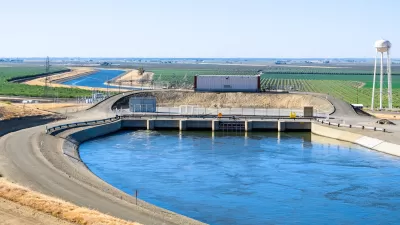After reading an article on the misuse of CEQA in California,* I took a short look at New York law. In New York, city planners must prepare an environmental assessment when property is rezoned, and must prepare a more detailed environmental impact statement (EIS) if property has a significant effect on the environment.
After reading an article on the misuse of CEQA in California,* I took a short look at New York law. In New York, city planners must prepare an environmental assessment when property is rezoned, and must prepare a more detailed environmental impact statement (EIS) if property has a significant effect on the environment.
For example, my property law textbook has the case of Fisher v. Giuliani (720 NYS 2d 50).** In that case, the city sought to allow additional development in certain parts of Manhattan's Theater District. According to the court, the rezoning "did modestly increase the density of particular sites via the transfer of development rights from theaters"- in other words, it allowed development to be transferred from blocks containing historic theaters to other blocks. The city prepared a 75-page environmental assessment. This assessment, however, was not enough for the local Not-In-My-Back-Yard lobby, which argued that a full-scale EIS was needed.
A New York trial court also endorsed a full-scale EIS, holding that the rezoning would create a significant impact because they would "stimulate development"- something that would be true of any upzoning, anywhere, anyplace, anytime. The New York appellate courts disagreed- but not until three years after the city approved the rezoning.
What do I get out of this case? First, that in states with environmental review statutes, any rezoning, anywhere, may be subject to years of bureaucratic review and court challenges that would not occur in other states.
Second, it seems to me that because developers in such states will need to wait for environmental assessment (and maybe for an environmental impact statement as well), environmental review statutes will therefore discourage any development requiring a rezoning, thus constricting the supply and raising the cost of both residential and commercial development.
Third, I suspect that the environmental review process may encourage development to shift towards outer suburbs. Here's why: I would guess that infill development is probably more likely to require rezoning than "greenfield" development of semirural areas, and is certainly less likely to attract neighborhood opposition since in the latter type of area fewer people are around to complain. Thus, the environmental review process may reduce infill development more than it reduces greenfield development. Having said that, I don't wish to overstate my case: New York and California are certainly high-cost states, but I am not sure how much of this high cost is related to environmental review status. Moreover, the central cities in California and New York (well, downstate New York anyhow) are healthier than those of many other states, indicating that if environmental review statutes favor sprawl, their impact is not enormous.
*http://www.planetizen.com/node/52413
**http://www.lexisone.com/lx1/caselaw/freecaselaw?action=OCLGetCaseDetail…

Alabama: Trump Terminates Settlements for Black Communities Harmed By Raw Sewage
Trump deemed the landmark civil rights agreement “illegal DEI and environmental justice policy.”

Study: Maui’s Plan to Convert Vacation Rentals to Long-Term Housing Could Cause Nearly $1 Billion Economic Loss
The plan would reduce visitor accommodation by 25% resulting in 1,900 jobs lost.

Planetizen Federal Action Tracker
A weekly monitor of how Trump’s orders and actions are impacting planners and planning in America.

Wind Energy on the Rise Despite Federal Policy Reversal
The Trump administration is revoking federal support for renewable energy, but demand for new projects continues unabated.

Passengers Flock to Caltrain After Electrification
The new electric trains are running faster and more reliably, leading to strong ridership growth on the Bay Area rail system.

Texas Churches Rally Behind ‘Yes in God’s Back Yard’ Legislation
Religious leaders want the state to reduce zoning regulations to streamline leasing church-owned land to housing developers.
Urban Design for Planners 1: Software Tools
This six-course series explores essential urban design concepts using open source software and equips planners with the tools they need to participate fully in the urban design process.
Planning for Universal Design
Learn the tools for implementing Universal Design in planning regulations.
Caltrans
Smith Gee Studio
Institute for Housing and Urban Development Studies (IHS)
City of Grandview
Harvard GSD Executive Education
Toledo-Lucas County Plan Commissions
Salt Lake City
NYU Wagner Graduate School of Public Service






























